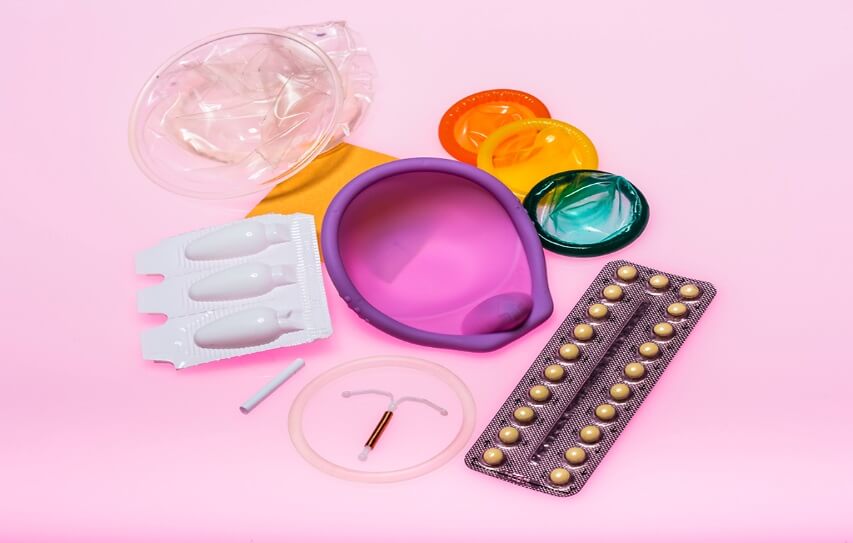Birth Control: Decisions, decisions, decisions!

Birth control options have increased dramatically in the past 50 years and with more choices, choosing the right one can be quite a task. Finding a contraceptive you trust will allow you to relax and have a fulfilling intimate relationship. The most important step is talking to your gynecologist and learning how your choice of birth control will affect your health. It is extremely important and critical to speak to your gynecologist or doctor to discuss these options and work with them to select the best method. We’ve put a list together of the common types of birth control available so check them out!
Terms to know:
- Progestin- a natural or synthetic hormone that prevents further ovulation.
- Estrogen- primary female sex hormone as well as medication.
- Spermicide- a substance that kills sperm.
Barrier Methods
– Condoms
Condoms come in two forms–male and female. The male condom is a sheath of latex, polyurethane that is worn over the male penis during sex. The female condom is a wider sheath of polyurethane that is placed inside the vagina before sex. Condoms are the only birth control method that work both against sexually transmitted infections and unwanted pregnancies.
– Diaphragm
This option is best for women who can not use hormonal birth control. A diaphragm is a dome shaped cup made of silicone. The diaphragm is inserted into the vagina along with spermicide to cover the cervix. You can put your diaphragm in up to 2 hours before sex–any longer and the spermicide will not work as well. Always leave your diaphragm in for 6 to 8 hours after sex. Your health care provider will find the right fit for you and show you how to put it in and take it out. The diaphragm is pretty easy to use once you get the hang of it– practice makes perfect!
Hormonal Methods
Hormonal contraceptives stop the ovaries from releasing eggs, without an egg there is nothing for the sperm to fertilize. Additionally, it makes cervical mucus thicker, which can also block sperm from reaching the egg.
– The Pill
The pill is a tablet you take once a day–there are a few different types of pills.
- The Combination Pill: The combination pills contains both estrogen and progestin. Combination pills work in two ways–they prevent your body from ovulating which prevents the release of eggs each month. Second, they cause the cervcial mucus to become thicker; the thickened mucus helps prevent sperm from reaching the uterus.
- Progestin Only Pills (The Mini Pill): The mini pill works by thickening the cervical mucus and by thinning the endometrium. The endometrium is the lining of your uterus where an egg implants after it is fertilized. When the linning is thinner, it is harder for an egg to implant it, which will prevent pregnancy.
– The Patch
The patch is a thin strip of plastic that contains estrogen and progestin. It is placed on the skin of the abdomen, buttocks, or upper body once per week for 3 weeks; on the 4th week you do not wear one. This method is best for women who have trouble remembering to take the pill each day. The patch contains 60% more estrogen than combination pills, so women who smoke, have high risks of blood clots, stroke or migraines should not use the patch.
– The Ring
The ring is a two inch flexible ring containing a combination of estrogen and progestin that is insterted into the vagina for 3 weeks and removed on the 4th.
– Progestin Shot
The shot is a progestin injection given every 3 months. It is one of the most effective forms of hormonal birth control and gives you 12 weeks of protection. This is best suited for women who want long term protection.
– Implant
The implant is a tiny piece of plastic, containing progestin that is inserted under the skin of your inner arm–it last for three years. This option is best for women who do not want to become pregnant for a long period of time.
– IUD
The IUD is a T shaped plastic inserted into your uterus by your doctor. The hormonal IUD releases a small amount of progestin hormones. The copper IUD uses a small amount of copper. The progestin IUD is effective for 5 years and the copper IUD is effective for 12 years.
Sources: https://www.bedsider.org/features/89-which-birth-control-pill-is-right-for-me https://www.optionsforsexualhealth.org/birth-control-pregnancy/birth-control-options http://americanpregnancy.org/preventing-pregnancy/types-of-birth-control/ https://studybreaks.com/2017/06/22/contraceptives/
